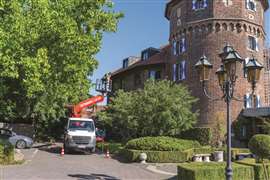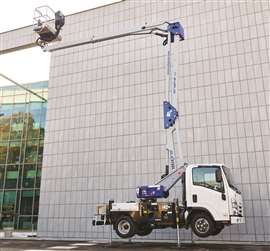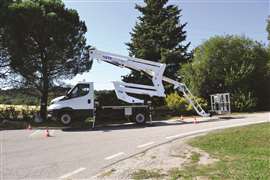Truck-mounts expand footprint in North America
25 September 2024
While the truck-mount market in North America isn’t quite as well-established as it is in Europe or the UK, some say the potential for growth and increased utilization across the US, Canada and Mexico is trending upward. Lindsey Anderson and Euan Youdale report.
“Where both the small and truck-mounted lifts have had their domain in the utility world, there is a tremendous drive in a lot of new sectors, including wind power, building maintenance, construction and other applications,” says Ebbe Christensen, president, Ruthmann Reachmaster N.A. “It is relatively unknown to the larger population of our industry that the truck-mounted segment has expanded its footprint into the more ‘general’ sector, replacing less safe (but cheaper) solutions as efficiency factors, along with safety concerns, have taken the driver’s seat in the market.”
According to Christensen, there are only three players in the North American, ultra-tall (250-feet or higher) truck-mount sector (which includes Ruthmann Reachmaster N.A.). When you compare that figure to the many, many scissor and boom lift OEMs present across the US, Canada and Mexico, it would seem that the market just isn’t interested in truck-mounted MEWPs. But Christensen sees it differently.
“Rental opportunities have not been here for these units before,” he says, adding, “There is a need for product education.”
From Mexico, with love
 Truck-mounts are in demand in a number of new applications including there is a tremendous drive in a lot of new sectors, including wind power, building maintenance, construction and more.
Truck-mounts are in demand in a number of new applications including there is a tremendous drive in a lot of new sectors, including wind power, building maintenance, construction and more.
Christensen points to Mateco’s involvement in Mexico’s growing equipment rental industry.
Mateco, a major European equipment rental company, officially entered the Mexican equipment rental market in 2022, and a year later, expanded its product offerings to include telehandlers, forklifts and truck-mounted aerials.
In April 2023, the rental company added additional Versalift and Ruthmann truck-mounts to its fleet.
Today, the company operates from two branch locations in the country, one in Tepotzotlán and the other in Puerto Morelos, and it offers a range of access and material handling equipment rental solutions. With 295-foot truck-mounts at its disposal, the company operates the highest-reaching fleet of truck-mounts in the country.
“The interesting part is that rental opportunities had not been in Mexico, nor the US, before,” Christensen says. “But now they are happening.”
“The demand for these big units is spawning and rapidly growing,” Christensen says. “While the Europeans refer to them as the 3.5-ton market – the limit before CDL in Europe – the units entering North America are modified versions that don’t have to observe the 3.5-ton limit and can go much higher while still remaining below the U.S. CDL.”
Maximizing performance
Compactness with maximum performance has long been Ruthmann’s mantra. Its latest offerings include the Steiger Ampero TBR 260 E, the new version of the Ecoline 270, and the Steiger T 1000 HF.
The Ampero TBR 260 E electric truck mount was launched recently during the IFAT 2024 exhibition in Munich.
The fully electric unit features a unique concept where the Iveco eDaily’s battery centrally powers both the driving and lifting mechanisms. This enables silent and emission-free operation on a 5.5- to 7.2-ton chassis.
There are plans for new hybrid and electric models with enhanced battery life, greater efficiency, and reduced environmental impact. However, as Christian Roß, head of international sales at Ruthmann, points out, while the company has the capability to build nearly all its products on fully electric trucks, the market is not yet ready to buy these combinations. “By investing in research and development, we aim to lead the industry in providing environmentally friendly alternatives that do not compromise on performance or reliability.”
Returning to traditionally powered models, the improved Ecoline 270 was introduced during Innovation Days in Hohenroda, Germany, this year.
It boasts a working height of 27m and a reach of 16m. Despite its powerful capabilities, it maintains a compact vehicle length of 7.53m and allows for setup at an incline of up to 5 degrees. Significant enhancements include a new user-friendly display, protected sensors, and optimized hose routing, making it more robust and easier to operate.
Long-term, says Roß, “Our focus will be on enhancing performance, safety, and environmental sustainability. We also aim to explore new markets and applications for our truck-mounts.”
The main challenges in the sector, adds Roß, include maintaining stability, ensuring safety, and optimizing weight distribution while providing longer outreach on a compact chassis.
“We are addressing these challenges through innovative engineering solutions, such as advanced materials, sophisticated stabilization technologies, and comprehensive testing.”
Developing and expanding
The potential in the truck-mount market has driven OEM Palfinger to develop its access platform product line to run parallel to its massive crane division, which forms the basis of the company.
“Our goal is to expand the access platforms into a second strong product line in addition to our main product, the loader crane. That is where our Löbau site plays a very special role,” said Alexander Susanek, COO at Palfinger. “Here, we have made investments specifically in product development, know-how and quality. With a larger capacity assembly line and our focus on service, we are now hitting the ground running.”
 The Oil & Steel Snake 16 has a compact 4.85m length and 1.86m width in transport position.
The Oil & Steel Snake 16 has a compact 4.85m length and 1.86m width in transport position.
In Köstendorf, close to the company’s headquarters in Bergheim, Austria, the company has set up a technology center for access platforms and have continuously expanded it in recent years.
During the past three years, Palfinger has invested more than €14 million in expanding the Löbau site, in the Görlitz region of Saxony, meaning that an area of around 78,000 square meters is now home to a state-of-the-art production hall, an in-house test area, a service center and offices. A total of around 300 people are employed in Löbau, a fifth more than two years ago.
Since 2023 the site has assembled the large platforms, adding to the light and premium class models. The company also has a strategic focus in the North American region, particularly the US.
Palfinger’s CEO Andreas Klauser delved further into the subject.
“We see significant growth potential in the area of access platforms. The product is extremely versatile and is used worldwide in various industries such as construction, energy, and logistics.”
Electrification will also play an important role in the company’s strategy, with the P 280 CK eDRIVE was one of the first low emissions access platforms on the market.
In addition to the fully electric chassis it is also possible to convert the existing fleet of access platforms to minimum emission operation quickly and easily using retrofittable eDrive battery packs. Because they are battery operated, these machines can work on job sites without a power supply at the same working speed as in diesel mode.
The new TEC Class line to be presented at Platformers Days, among other shows this year will be in the 19m to 28m working height range, which has been significantly improved and visually redesigned, including the expansion of the eDRIVE capabilities. All models are equipped with the option of installing an eDRIVE battery pack as standard.
In addition, numerous performance upgrades have been made and modularity between components has been implemented in order to simplify servicing and make it more efficient. Digital solutions such as improved connectivity and integration into various fleet management systems have also been considered. All new models are also compatible with the new GSR2 regulations (General Safety Regulation.)
What’s new?
Versalift recently launched the updated VTL-130-FZ and VDTL-160-FZ modified to fit the new 2024 Ford Ranger pickup, while the new V-200 is mounted on a 3.5-ton Iveco Daily.
The V-200 is a high-performance telescopic lift that comes with automatic stabilization as standard, and is installed on either the Iveco Daily or MB Sprinter.
In transport position, the V-200 is less than 3m tall, with a working height of 20.4m and a horizontal reach of 14m, while the wide working diagram provides versatility for operators.
The impressive maximum bucket capacity of 300kg allows up to two operators to carry a good deal of equipment and tools with them. Constructed from high-strength steel, both the V200 and the subframe are lightweight yet robust, offering ample spare payload to install additional Versalift hybrid systems like the e-Tech lithium battery pack system.
The Versalift automatic stabilization and levelling system enhances safety and makes stabilization maneuvering hassle-free and can be performed from the bucket or from the optional control panel located at the rear of the vehicle.
The company is constantly looking into the most modern fabrication methods to make the lifts as light and compact as possible.
In addition, the company says its receives a lot of requests for 100% electrical solutions, with vehicles with the longest ranges being favored. “With the e-Tech range of battery packs we can offer a hybrid solution for all of our lifts and we already offer installations on several fully electrical chassis and vans.”
Engineering challenges
 CTE launched the ZETA 24 J at the GIS Expo in Italy last fall.
CTE launched the ZETA 24 J at the GIS Expo in Italy last fall.
CTE agrees that the main challenges in the industry are engineering, designing and manufacturing lighter structures to maintain stiffness and resistance to fatigue. The company is achieving this through its latest product, the ZETA 24 J, launched it at the GIS Expo in Italy, last October.
Set up on a 3.5-ton GVW chassis it has an articulated boom which allows maximum performance across the work area, and ideal for world of rental. It is also the only double articulated platform with jib, says the company, that can position the basket close to the ground for easy access.
The 24m model pairs with the smaller Zeta 22, that was introduced in 2022, and completes the updated range of double-articulated pantograph lifts, with three-section telescopic boom and fly jib, building on the concept of the original Z model of the 90s, while integrating the EVO management system.
A narrow jacking stabilizer is designed combines with an up & over that are impressive, considering the small footprint of the narrow jacks, offering to the operator great versatility as well as excellent working envelope.
Its main features: 24 m of working height, 10.5 m of outreach and a basket capacity of 250kg. Going forward CTE is concentrating on new EU regulations in terms of GVW, without compromising performances of the MEWP.
There will also be a focus on installing the 20m working height electric-powered MP20EV on a new electric chassis, as part of the company’s Green project.
CTE’s plan is also to redesign and redefine MEWPS over 3.5 tons, introducing the EVO system on heavy duty units. Below 3.5 tons, there will be a focus on electric and hybrid.
Italian design
GSR, which specializes in easy-to-use equipment, most recently launched the 13.15m working height B270T Comfort XEE - a telescopic platform installed on a 3.5-ton vehicle. The high-performance machine in terms of height and outreach is designed to be very simple to use while remaining faithful to the company‘s design principle of robustness and reliability.
A new van-mounted version with 14m height will be released soon. There will also be new fittings designed to be common to truck mounted models, which themselves are constantly evolving technically in terms of
 GSR says its goal is to create new technologies that increase performance and are easy to manage for customers.
GSR says its goal is to create new technologies that increase performance and are easy to manage for customers.
safety and energy saving.
“The challenge is the search for new technologies that increase performance and are easy to manage for our customers,“ said the company.
On the green energy side, the company said it is focused on this and will take on the challenge of producing an electric model in the near future. And trends are towards very low consumption internal combustion engines, or endothermic engines, “which are being talked about a lot at the moment.“ Hydrogen engines are also on the rise, says CTE.
Confined designs
Compactness is a focal point of Oil & Steel too, with its recently introduced Snake 16 and Snake 24FB at the GIS show in Italy last year and the Snake 26 at the company’s open house in June this year.
The Snake 16 is denoted by a compact 4.85m length and 1.86m width in transport position. The in-shape stabilization width is just 1.75m.
Designed to be easy to use it has one unrestricted working area of 220kg and hydraulic controls with telemetry and remote diagnostics.
The Snake 24FB has a flat basket for roofers, and in shape stabilization, combined with a 13m outreach, 250kg load. Advanced features include return home and position save and load. An advanced HMI basket console with 4-inch color display, emergency controls on the frame, 7 inch color display on the turret as optional, with all main parameters available for the operator, along with automatic stabilization as option, are all features.
The latest launch is the Snake 26, with automatic stabilization as standard, and designated as a sturdy unit with narrow stabilization, H-shape outriggers and variable stabilization.
Advanced electronic functions include return home and position save and load and the previously mentioned display and controls.
Range-topping introduction
Coming up soon will be the new range-topping telescopic Scorpion 18, which completes the 3.5-ton range, with electric controls, H outriggers and variable stabilization as standard, the advanced HMI and electronic functions, as well as telematics and remote diagnostics.
Looking forward, the company is also uncertain of the future of electric chassis, although is more convinced about electric lifts. “We have mixed signals from the market after an initial period of interest from customers, the demand has practically disappeared.”
“As far as hybrid machines are concerned, we are extending the application of the batteries to more models and at the same time working on the characteristics of battery packs themselves - compactness, cost, characteristics.”
New thinner, higher-strength materials are also in the mix, for different machine geometry and articulation.
Advanced designs are also on the menu for greater strength and less deformation and compactness in transport position, as well as compact stabilization even at the expense of flow performance especially important for southern European markets.
CONTÁCTESE CON EL EQUIPO






